
Different Types of Thermometers
Whether you own a restaurant, manage a catering business, or operate any other food service establishment, having the right thermometer is essential for maintaining food safety standards and ensuring the health and satisfaction of your customers. There are several different types of food thermometers, each with their own unique features and benefits. It's important to choose the thermometer that best fits your needs, and we've outlined the different types of thermometers and what they do below.
Shop All Food Thermometers
Use the following links to skip to the thermometer information that most interests you:
- Infrared Thermometers
- Oven Thermometers and Grill Thermometers
- Candy Thermometers
- Refrigerator Thermometers and Freezer Thermometers
- Thermocouple Thermometers
- Probe Thermometers
- Wall Thermometers
- Dishwasher Thermometers
- Frothing Thermometers
- Food Thermometer Calibration
- What Should You Do After Using a Food Thermometer?
Types of Food Thermometers
With so many options available, choosing a food thermometer for your commercial kitchen can be overwhelming. Before you make a purchase, consider the following factors:
- Accuracy: You need a thermometer that provides precise and reliable readings to ensure the safety of your food. Look for thermometers that have been calibrated for accuracy and have a high degree of precision.
- Temperature range: Some thermometers are designed specifically for measuring the temperature of meat, while others can handle a wide range of temperatures for various culinary applications. Choose a thermometer with a temperature range that matches your menu.
- Speed: In a busy commercial kitchen, every second counts. Look for thermometers that provide fast and accurate readings, allowing you to quickly assess the temperature of your food without wasting precious time.
- Temperature recording: Some thermometers feature built-in memory functions that allow you to record and store temperature readings for future reference or compliance with regulations. This is useful when monitoring the temperature of perishable items or during HACCP inspections.

Sometimes referred to as laser thermometers, non-contact thermometers, or temperature guns, infrared thermometers offer a convenient and efficient way to measure surface temperatures from a distance. Infrared thermometers work by gauging the intensity of thermal radiation emitted by the subject, allowing you to measure temperature without making physical contact. Whether you're measuring the surface temperature of a pot or pan, ensuring that foods are being held at food-safe temperatures, or checking the temperature of equipment or machinery, infrared thermometers allow you to obtain quick and accurate readings without any hassle.
- Type: Digital thermometer
- Applications: Measuring surface temperature and spot-checking foods

Oven thermometers and grill thermometers can withstand high temperatures and feature a high temperature range, making them reliable tools for your kitchen. They are placed inside an oven or grill, providing accurate readings of the appliance's internal temperature. One of their key benefits is that they allow you to test for hot spots, which can often occur in grills and ovens and result in uneven cooking. They also make it easy to find the ideal position to place your food in the oven, allowing you to achieve consistent and reliable results every time you cook.
- Type: Dial thermometer
- Applications: Baking, grilling, and checking the internal temperatures of appliances
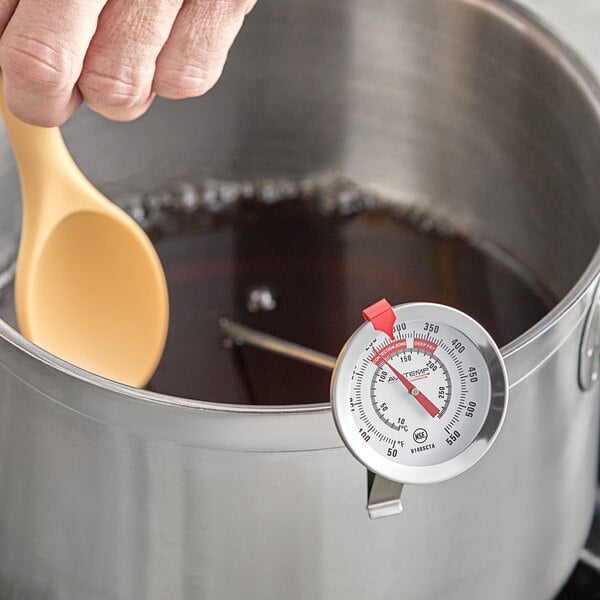
Candy and deep fry thermometers handle the extreme temperatures required for boiling oil or sugar. Whether you're preparing bulk candy for your candy shop or making fried foods in your concession stand, these thermometers are an excellent tool to have on hand. Most candy thermometers feature a built-in clip and a long probe that can be submerged into the liquid, allowing you to monitor candy temperatures. Many types also come with easy-to-read temperature scales and indicators, making them user-friendly even for those new to candy-making or deep frying.
- Type: Dial thermometer or digital thermometer
- Applications: Candy making and deep frying

Refrigerator and freezer thermometers monitor the internal temperature of your refrigerators and freezers, ensuring perishable items are stored in optimal conditions. They withstand the chilly environment of your refrigerator or freezer, ensuring accuracy even in the coldest conditions. These thermometers come in several different styles including cabinet mount thermometers, hanging thermometers, and standing thermometers, ensuring you find the model that matches the layout of your refrigerator or freezer.
- Type: Dial thermometer or digital thermometer
- Applications: Monitoring refrigerator and freezer temperatures

Thermocouple thermometers withstand high heat and moisture while providing quick, accurate readings making them a popular choice for many commercial kitchens. They are ideal for a wide range of time-sensitive tasks, including checking the doneness of meat or monitoring the temperature of liquids while cooking or baking. Unlike other thermometers that may take a few seconds to display an accurate reading, thermocouple thermometers provide almost instant temperature measurements. While their temperature range can vary depending on the unit, some thermocouple thermometers can measure up to 2,500 degrees Fahrenheit.
- Type: Digital thermometer
- Applications: Spot checking foods and monitoring perishable foods

Probe thermometers feature large probes that are inserted into the thickest part of food, allowing you to monitor internal cooking temperatures with ease. These thermometers are typically used for cooking meat and help to reduce the risk of foodborne illness. By measuring the internal temperature, probe thermometers ensure that harmful bacteria, such as salmonella or E. coli, are killed off during cooking. Some probe thermometers feature built-in alarms and can be inserted into the food as it cooks, alerting you when the food has reached your desired temperature.
- Type: Dial thermometer or digital thermometer
- Applications: Checking the internal temperature of meat

Wall thermometers can be mounted on nearly any wall or surface that you see fit, making them suitable for a variety of commercial applications. Whether you need to monitor the temperature in a warehouse, office, or restaurant, wall thermometers are an excellent addition to your workspace. Many wall thermometers feature increased moisture resistance, allowing them to withstand the elements and making them ideal for both indoor and outdoor use. Rain or shine, these thermometers will continue providing accurate temperature readings without compromising their functionality.
- Type: Dial thermometer or digital thermometer
- Applications: Monitoring indoor and outdoor temperatures
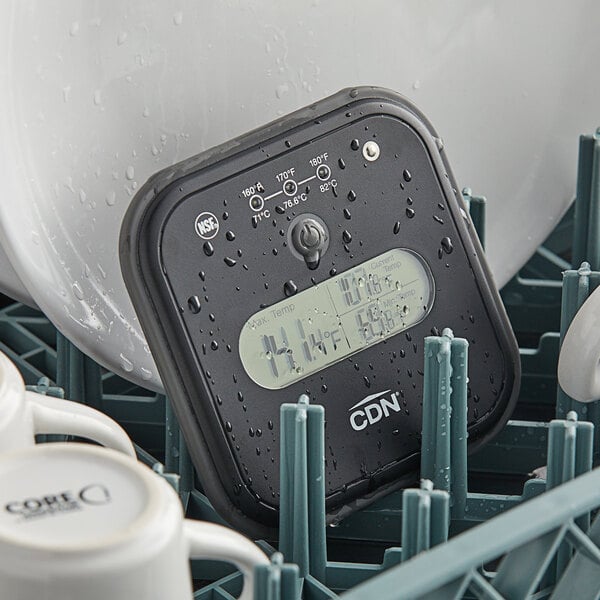
Dishwasher thermometers are built to withstand high temperatures and moisture inside your commercial dishwasher, ensuring the unit operates at a hot enough temperature to sanitize dishes. There are several different styles of dishwasher thermometers available, each with unique features. One popular option is the disposable dishwasher thermometer, designed for single use and is often attached to a dish rack or utensil basket. You can also use a dishwasher probe, which can be inserted into a dish or utensil during the wash cycle to provide real-time temperature readings.
- Type: Dial thermometers or digital thermometers
- Applications: Monitoring internal dishwasher temperatures
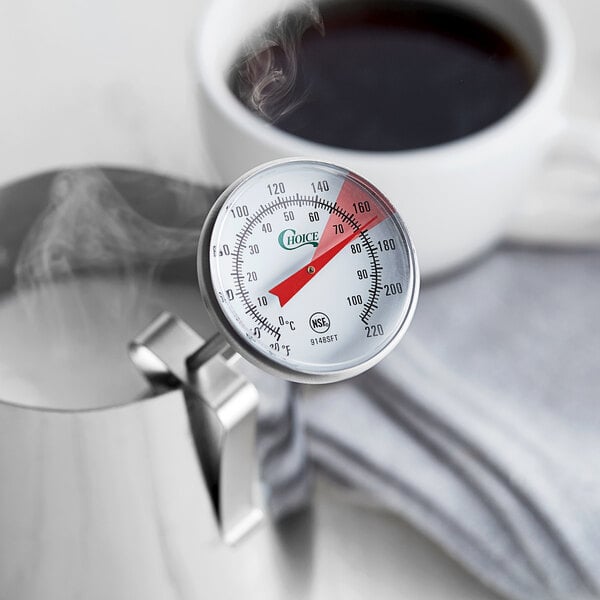
Frothing thermometers are a specific type of thermometer designed to measure liquid temperatures, especially hot milk. They are used by baristas and other professionals in the coffee industry who strive for consistency and precision in their craft. One of the key features of a frothing thermometer is its clip, used to fasten it securely to the side of a frothing pitcher and ensure it stays in place while you're steaming or frothing milk. This hands-free operation is essential for your barista staff. These thermometers also feature a long probe, allowing them to reach deep into milk and other liquids and provide accurate readings.
- Type: Dial thermometer
- Applications: Coffee shops and cafes
Every thermometer will need to be calibrated from time to time. We'll answer some common questions about food thermometer calibration below.
How Often Should a Food Thermometer Be Calibrated?
Calibrate your food thermometers daily to ensure accurate temperature readings. In addition to daily calibration, recalibrate your thermometer after any extreme temperature changes. For example, if you've been using your thermometer to measure the temperature of hot food and then need to use it to measure the temperature of cold food, recalibration is necessary. Extreme temperature changes can affect accuracy, so it's important to recalibrate to ensure accurate readings. All calibrated food thermometers should be accurate within 2 degrees plus or minus.
How to Calibrate a Food Thermometer
There are two methods to calibrate stem thermometers: the ice water method and the boiling point method. We'll explain both methods below:
Ice Water Thermometer Calibration
- Submerge the thermometer stem in the mixture for 30 seconds or until the indicator stops moving.
- Submerge the thermometer stem in the mixture for 30 seconds or until the indicator stops moving.
- Verify that the temperature being displayed is 32 degrees Fahrenheit. This is the freezing point of water.
- If the thermometer does not read 32 degrees Fahrenheit, recalibrate the thermometer until it does. This can be achieved by turning the calibration nut on a dial thermometer or pushing the reset button on a digital thermometer.
Boiling Point Thermometer Calibration
- Heat a deep pot of water until it begins to boil.
- Submerge the thermometer step in the pot for 30 seconds or until it stops moving.
- Verify that the temperature being displayed is 212 degrees Fahrenheit. This is the boiling point of water.
- If the thermometer does not read 212 degrees Fahrenheit, recalibrate the thermometer until it does. This can be achieved by turning the calibration nut on a dial thermometer or pushing the reset button on a digital thermometer.
Just like any other utensil or tool that comes into contact with food in the kitchen, you should clean your food thermometer after use. Wash your thermometer by hand using hot soapy water. This will help remove any residue or bacteria that may have accumulated on the surface during use.
Keep in mind that not all thermometers can be fully immersed in water. While some models are designed to be waterproof and can be submerged, others are not. It's always a good idea to check the manufacturer's instructions for specific cleaning guidelines. If your thermometer is not waterproof, you can still clean it effectively by wiping it down with a damp cloth or using a sanitizing wipe. Just make sure to avoid getting the display or any electrical components wet.
Related Resources

September 2024 WebstaurantStore Coupon Code
Fall is almost here, and to celebrate Webstaurantstore is offering a selection of amazing deals! In September, you'll discover incredible prices on classic fall flavors, glassware, cold cups, and much more! Take a look at our selection of sale items below and don't forget to enter the code COZY24 at checkout to enjoy savings of up to 25%! We're also excited to introduce the new Webstaurant Rewards® Visa Business Card ! Sign up for a new card today and start earning rewards on every WebstaurantStore purchase. Discover the latest discounts on consumable food and beverage items with September's monthly coupon code. From ready-to-bake pastries to classic fall flavoring mixes, you can find great deals on essential consumables for your commercial
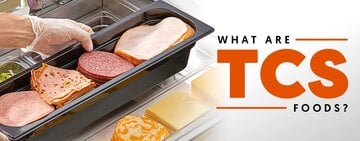
What Are TCS Foods?
You already know that food safety is extremely important, and that cross-contamination can lead to foodborne illness. But did you know there are certain foods that require special handling when it comes to time and temperature control? These foods are called TCS foods, and you might be surprised by some of the items on the list. We'll explain why these particular foods cause a problem and how you can handle them in the safest way possible. Click below to learn about the different types of TCS foods: Meat and Poultry Milk and Dairy Fish and Shellfish Eggs Tofu and Soy Cooked Potatoes Sprouts Cut Leafy Greens Cut Tomatoes and Melons Cooked Rice, Beans, and Grains Garlic and Oil Mixtures TCS Food FAQs TCS Foods Chart What Is TCS Food? TCS stan
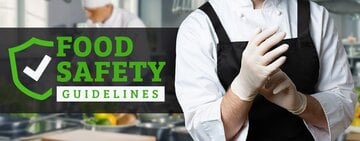
Food Safety Guidelines
Food safety guidelines are put in place to keep customers safe and prevent the risk of a foodborne illness outbreak. Any operation that serves food should establish protocols that meet the legal requirements for safe food handling. In this guide, we'll outline the most important aspects of food safety to help you build an effective program for your business and pass your next health inspection . Click below to learn about important food safety programs: Personal Hygiene Proper Food Handling Cleaning and Sanitizing Pest Control Purchase from Approved Suppliers Food Safety Training Food Safety Guidelines for Restaurants We'll cover the most important aspects of a successful food safety program so you can prevent a foodborne illness outbreak a
- Topics 1404
- Industrial 55
- Troubleshooting Guides 23
- Restaurant Management 130
- Bar Management 59
- Catering Tips 38
- Bakery Management 43
- Food Trucks & Concessions 50
- Advertising & Marketing 37
- Eco-Friendly Tips 11
- Facility Layout & Design 44
- Coffee Shop Tips 30
- Installation & Maintenance 55
- Janitorial & Pest Control 30
- Safety & Sanitation 95
- Startup Tips 104
- Menu Design 10
- Kitchen & Cooking Tips 85
- Hospitality Management 24
- Pizza & Sandwich Shop Tips 37
- Smallwares 37
- Food Prep 97
- Tabletop Items 18
- Disposables 23
- Calculators & Tools 6
- Consumables 53
- Warewashing & Laundry 18
- Cooking Equipment 96
- Food Storage & Refrigeration 52
- Beverage Equipment 38
- Office Supplies 6


